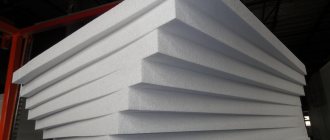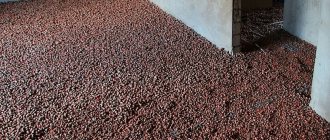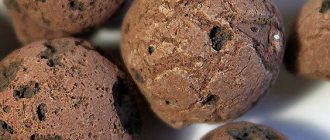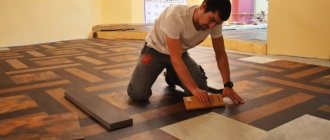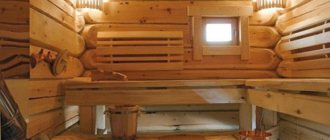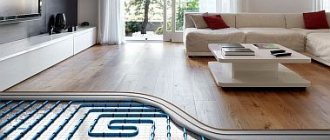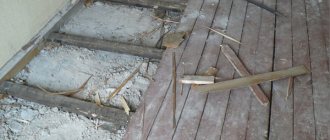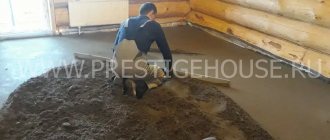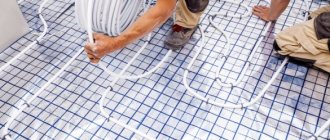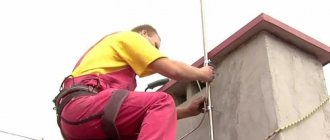Strength of cement-sand screed
Screeds - the base under the floor covering - should be used in cases where it is necessary:
- leveling the surface of the underlying floor layer or ceiling;
— covering built-in pipelines and electric heating cables;
— distribution of loads across heat and sound insulating layers;
— ensuring standardized heat absorption of the floor.
Before you begin laying the flooring, you should take into account the design and composition of the screed. According to their design, screeds can be divided into the following main types:
- screeds on the base, on the dividing (waterproofing) and heat-insulating layer;
— prefabricated screeds, etc.
The most common bases for floor coverings in residential, public, administrative and domestic buildings are: concrete screeds, lightweight concrete, asphalt concrete, cement-sand, gypsum, polymer-cement leveling layer, prefabricated screeds made of wood-shavings, cement-shavings, gypsum fiber boards, plywood, and also boardwalks.
The minimum thickness of the screed when laying it on floor slabs is 20 mm, on a heat or sound insulating layer - 40 mm. The thickness of the screed for covering pipelines should be 10-15 mm greater than their diameter.
Screeds based on compressive strength should be assigned:
— to level the surface of the underlying layer of concrete of class not lower than B 12.5 (M150), cement-sand mortar with a strength of not lower than 15 MPa (150 kgf/cm);
— for self-leveling polymer coatings — from concrete of class not lower than B 15 (M200) or cement-sand mortar with a strength of at least 20 MPa (200 kgf/cm ).
Lightweight concrete screeds made to ensure normal heat absorption of the floor must comply with class B 5 (M75).
The bending strength of lightweight concrete for screeds laid over a layer of compressible heat or sound insulating materials must be at least 2.5 MPa (25 kgf/cm2).
For concentrated loads on the floor of more than 2 kN (200 kgf), thermal or sound insulation should be made of a concrete layer, the thickness of which is determined by calculation.
The strength of gypsum screeds (in a dried to constant weight state) must be no less than:
— for self-leveling polymer coatings — 20 MPa (200 kgf/cm);
- for other coatings -10 MPa (100 kgf/cm ).
Prefabricated screeds made from wood-shaving, cement-bonded particle boards and gypsum fiber boards, as well as screeds made from porous cement mortars, should be accepted according to standard working drawings.
Prefabricated screeds made of wood fiber boards are used in floor structures to ensure normal heat absorption of the floor surface of the first floors of residential and office premises.
Asphalt concrete screeds are allowed only under coverings made of piece tongue-and-groove parquet.
When installing continuous screeds made of concrete and cement-sand mortar, the compositions of the mixtures and the technology of work are similar to those used when installing coatings of the same name. The brand of concrete and mortar mixtures and the thickness of the screed are taken according to the project or according to the above indicators.
The mobility of concrete should correspond to the cone settlement of 2-4 cm (Fig. 1), and the cement-sand mortar should correspond to the immersion depth of the StroyTsNIL cone of 4-5 cm (Fig. 2).
Fig.1. Scheme for determining the mobility (slump value of the cone) of a concrete mixture
Fig.2. StroyTsNIL cone (version with shortened rod):
A
- side view;
b
- section along A-A: 1 - tube for filling ballast;
2 - ballast; c
- top view
To increase the mobility of concrete and mortar mixtures, accelerate setting and strength gain, it is recommended to add plasticizers C-3, C-5, etc. as additives to the compositions. The plasticity of mixtures cannot be increased by increasing the amount of water, because a change in the water-cement ratio will inevitably lead to a decrease in the specified strength of the mortar, as well as the formation of shrinkage cracks. Solid screeds made of concrete and cement-sand mortars cannot be cut into cards. In rooms with standardized sound insulation, the screed is separated from the walls and partitions by elastic gaskets made from strips of soundproofing boards. The surface of leveling screeds under coatings laid on mastic and adhesive layers is smoothed with metal trowels or trowels.
When installing screeds, the following technical requirements must be met.
1. Screeds made on soundproofing pads or backfills, in places adjacent to walls and partitions and other structures, must be laid with a gap of 20-50 mm over the entire thickness and filled with a similar soundproofing material; Monolithic screeds must be insulated from walls and partitions with strips of waterproofing materials.
2. The end surfaces of the laid section of monolithic screeds, after removing the beacon or restrictive slats, before laying the mixture in the adjacent section of the screed, must be primed or moistened, and the working seam should be smoothed until unnoticeable.
3. The primer must be done over the entire surface without gaps before applying construction mixtures, mastics, adhesives, etc. (based on bitumen, tar, synthetic resins and aqueous polymer dispersions) to the lower element with a composition corresponding to the material of the polymers, mastics or glue.
4. Moistening of the surface layer of floor elements made of concrete and cement-sand mortar should be done before laying construction mixtures of cement and gypsum binders on them. Humidification is carried out until the final absorption of water.
5. Smoothing the surface of monolithic screeds should be done under coatings on mastics and adhesive layers and under continuous (seamless) polymer coatings before the mixtures set.
6. Sealing the joints of prefabricated screeds made of fibreboards should be done along the entire length of the joints with strips of adhesive tape 40-60 mm wide.
Cement-sand screeds
made from cement-sand mortar 1:3:0.55 (cement:sand:water) with a compressive strength of at least 150 kgf/cm or use ready-made dry mixtures M200.
The top of the screed should be below the finished floor mark by the thickness of the coating. These marks are placed on the walls, from which they are transferred to the beacons using a level and a control rod, or modern construction laser levels are used for these purposes, which make it possible to level horizontal planes with an accuracy of 0.1-0.5 mm/m. The first row of lighthouse guide rails is laid at a distance of 20-30 cm from the wall, the rest are placed at a distance of 1.5-2 m parallel to the first row. Each beacon is placed on small fastening marks made of mortar, embedding them to the required level. The cement-sand screed is laid in strips between two lighthouse guides and leveled.
Access to the full version of this document is restricted
You can familiarize yourself with the document by ordering a free demonstration of the Codex and Tekhekspert systems.
Cement-sand screed
A screed made from a mortar made from sand and cement is an almost perfectly flat base that is suitable for laying absolutely any floor covering, be it tile, laminate, linoleum or parquet. It is with the help of such a screed that most often they level rough foundations - concrete floors in houses, brick floors, and even simply create a foundation lying on ordinary soil. On average, the thickness of a cement-sand screed varies from 3 to 8 cm. It can be larger, but due to the large weight of the mortar used for pouring, when calculating the thickness of the screed, it is necessary to take into account the strength of the floors.
Cement-sand floor screed
Concrete floors are leveled using cement-sand screed
The main tasks of the screed are not only to level the surface, but also to the fact that it will redistribute the loads experienced by the floor, create a solid foundation, make it possible to equip heat and waterproof layers, and even in itself is an excellent option for heat and waterproofing. Inside this structure, you can lay various types of communications, equip a heated floor system, etc.
Reinforced screed on the ground
On a note! Certain types of screeds, called self-leveling floors, will help bring to life the most daring design solutions. Such floors can be of different colors or have a very interesting pattern. Special compositions make it possible to create real 3D paintings on the floor.
3D self-leveling floor in the bathroom
Tools
To create a self-leveling floor, the following tools are required:
- Containers for stirring mixtures and water.
- Construction mixer, electric drill with attachment.
- Putty knife.
- Raklya.
Roller, paint shoes
- Use a needle roller to remove air from the solution.
- Special shoes with spikes for walking on mortar.
- Typically, building level.
- Electronic humidity meter.
- Primer roller.
After preparing the tools, materials, and base for work, the pouring of the self-leveling floor begins.
Benefits and Features
Cement-sand screed has many advantages. This applies to its physical and physico-chemical parameters.
Cement-sand floor screed
Advantages of sand-cement screed.
- Evenness . Thanks to this method of leveling the floor, you can create an almost perfectly level base.
- Durability . Such a screed can easily serve for decades - on average, the service life is about 50 years.
- Durability . The screed does not deform under the pressure of heavy furniture; it is one of the most durable types of bases for a finished floor.
- Possibility to hide communications . Inside the screed you can lay water or sewer pipes, a heated floor system, or electrical wires. There they will not disturb anyone and cannot be damaged. If it is necessary to repair communications laid inside the screed, the cement-sand layer will have to be partially or completely dismantled.
Warm floor scheme
Leveling screed over insulation
But, like any other method of leveling the floor, cement-sand screed has its drawbacks, which you should be aware of before installing this type of base. The disadvantages of cement-sand screed are given below.
- Considerable mass . Cement screed exerts significant pressure on the floors, and therefore its use may be limited by this factor. For example, 1 m 2 of cement-sand screed, laid in a layer of 1 cm, weighs about 20 kg.
- Long drying time . Before you can safely move on the screed and carry out further finishing of the floor, it is necessary to dry it well. The drying time is long - about a month.
- It is difficult to achieve a smooth surface by hand . Fortunately, if this was not possible, but evenness is necessary, you can pour a self-leveling mixture on top of the screed.
- Difficult installation . Pouring screed is a very complex process, which is often carried out with the help of strangers. The work, of course, can be done independently, but it is important to follow all the steps and key points when pouring the screed. Otherwise it will crack.
Cracks in the screed
In any case, a properly poured screed is an excellent base option for any type of finishing coating. In addition, after drying during use, it is easy to clean, even if not covered with finishing, and is also not afraid of water.
Final advice
Quite often, a screed (especially a massive one) is used to hide communications: electrical lines, sewerage, water supply, heating networks.
Over time, the location of their installation is forgotten and there is a danger of their damage (for example, when installing plumbing or installing built-in furniture).
To prevent this from happening, carefully lay all communications before pouring the screed and carefully fix them with metal clamps attached to the floor - this will prevent them from moving or even floating up when pouring the solution.
And then the communications layout is carefully sketched or photographed - in order to have a detailed diagram of their location in the future.
Of course, there are methods for finding the location of pipes or wires in a screed array, but they require additional tools. It is much easier to restore the picture according to the scheme made in advance.
Types of cement screeds
There are a large number of ways to make such a screed. However, we can distinguish the main ones - tied and untied screeds and floating.
bonded screed method is used if the permissible leveling layer can be up to 4 cm thick. The base becomes one with the floor and walls. This type of screed requires careful preliminary preparation of the rough foundation - all large holes, cracks, cracks in the floors are sealed, all significant irregularities are removed as much as possible. If there are small bumps or pits on the surface of the ceiling, they do not need to be sealed. Builders even recommend artificially roughening freshly laid floors by walking over them with a metal brush - this way, the adhesion of the mortar to the surface will be better.
The solution for pouring the screed should have the consistency of sour cream or cake cream. It turns out quite liquid and about 20 minutes after pouring it will begin to gradually harden. Therefore, you need to have time to fill and arrange the screed during this time.
The solution for pouring the screed should have the consistency of sour cream
Attention! Large rooms are usually filled in stages, since one person cannot quickly level such an amount of mixture.
You can carefully walk around the room the next day, but the drying time for such a screed is long - up to 40 days. It is important to properly dry such a base - the water cannot quickly evaporate from the layer, it must come out gradually, so it is recommended to moisten the fresh screed with water and cover it with film.
There is an untied screed , which, on the contrary, is mounted on a perfectly smooth surface. In this case, the base should not have water-absorbing properties, so as not to draw moisture out of the screed. The thickness of such a layer can reach 5 cm. The main difference from the previous type is that a primer is not used before pouring such a screed. Also, no methods are used that can increase the adhesion strength of the solution and the rough base.
Floor screed - mortar and grout
Also often installed is a so-called floating screed . It is usually used if its thickness should be 5-7 cm. The design of such a layer is different in that it does not even directly come into contact with the rough base - on the contrary, layers of hydro- and thermal insulation are laid between the solution and it, various materials that simply will not give the solution will adhere to the ceiling.
Attention! It is this type of screed that is most often strengthened using reinforcing mesh. Fiber fiber can also be added to the solution to increase its strength, reduce the risk of cracks and reduce the risk of shrinkage.
Fiber fiber for floor screed
Fiber fiber mixture
Due to its large thickness, such a screed could have the maximum weight, but it is poured using the so-called semi-dry technology. That is, the solution is mixed using a small amount of water and resembles the structure of wet sand.
Prices for fiberglass for screeds
Semi-dry screed over heated floor
Video material
The use of specialized troweling equipment is the most progressive and inexpensive way to treat surfaces. After the finishing procedure, the floor is perfectly clean and smooth, even free of dust. The use of coloring compounds gives the floor an aesthetic appearance. The combination of work operations such as laying and grouting the floor screed helps reduce construction time. Another advantage of technology using topping is its versatility and the ability to be used on different objects.
Proportions of cement and sand
Depending on which screed option is chosen, the composition of the mixture for its manufacture is also determined. The proportions of the two main components are selected depending on what brand of cement will be used and what quality of sand. To install a screed in an apartment, it is enough to use M200 cement. The finished base will be able to withstand a significant load - about 200 kg/cm³. You can take 1 part of M500 cement and mix it with 3 parts of sand. And you will need as much water as is necessary for the solution to achieve the required consistency. This is approximately 1 liter per 1 kg of cement.
Attention! There is no need to add a lot of water, as this will make the solution of less quality.
Screed mortar
It is very important to choose the right sand to create the solution. It should not contain (or at least contain) various inclusions - silt, clay, etc. These components negatively affect the strength characteristics of the finished screed. It is best to use washed river sand. Quarry sand is also suitable, but its quality is somewhat worse than river sand due to the angular shape of the sand grains.
Table. Mixture compositions according to GOST when using M400 cement, wt. h.
| Brand of solution | Cement | Water | Sand |
| 150 | 1 | 0,55 | 3 |
| 200 | 1 | 0,48 | 2,8 |
| 300 | 1 | 0,4 | 2,4 |
Calculator for calculating the amount of ingredients of a mortar for floor screed
Cement for floor screed: proportions of cement mortar, grade
Most modern projects of private houses, not to mention city apartments, involve the abandonment of wooden logs in favor of prefabricated floors made of reinforced concrete slabs or the installation of slabs on site using monolithic technology. To level such a floor, cement-sand or concrete screeds are used. Their functions also include raising the subfloor to the desired level and creating a smooth surface necessary for laying the finishing coating. These mixtures are made based on cement, water and sand. The difference between a concrete screed and a cement-sand screed is the presence of coarse aggregate (granite, gravel, crushed limestone). Let's take a closer look at what cement is used to make floor screeds and what proportions of the components are optimal.
Devices for measuring the evenness of the base
| Laser levels | Leveling rod |
| |
Problems with the evenness of the base appear |
|
| |
| |
| |
| |
|
What grades of cement are best used for floor screed?
Most often, when carrying out construction and construction and repair work, which includes floor screeding, Portland cement grade M400 is used. The index in the marking corresponds to the load at which the material maintains its performance characteristics. After hardening, M400 cement can withstand forces of up to 40 MPa. Setting of the mixture based on this binder begins after about 1.5 hours and ends after 2-2.5 hours. After the brand, the designation includes the letter “D” and a number indicating the presence of mineral additives in %.
- M400 D0 is a material consisting only of clinker. There are no additives in it.
- M400 D5. The amount of mineral additives is up to 5%.
This marking, familiar to everyone, is regulated by the old GOST 101785-85. It was replaced by GOST 31108-2003, and then 31108-2016. They have adopted a new cement marking. The letters CEM are indicated at the beginning. The letter group is followed by Roman numerals I or II (for Portland cement). Number I indicates the absence of additives or their total content is not more than 6%, II – the presence of additives within 35%. Compressive strength in these standards is characterized not by brand, but by class. Thus, the material of the M400 brand corresponds to a product of strength class B32.5. According to the new marking, cements M400 D0 and M400 D5 correspond to the material CEM I 32.5.
What kind of cement is needed for floor screeds that experience increased loads or are operated at low temperatures? For this purpose, the binder CEM I 42.5 (M500 D0) is usually used.
What is Portland cement?
Portland cement consists largely of calcium silicate - belite and alite in its composition, it reaches almost 80% of the total composition, this type of cement is most popular all over the world, and it received its name thanks to the island located in the UK because the rocks located on it have identical color.
The composition of Portland cement includes clinker, gypsum, and mineral additives can also be included to improve characteristics - this composition of components provides the cement with a rapid hardening process in air and water.
After the process of firing the components is completed, the clinker is allowed to cool and then thoroughly crushed, turning into dust, so that the sulfur oxide in the finished product is within the normal range of 1.5 to 3.5%, gypsum is added to the cement.
What points are important when buying cement for screed?
The characteristics of the binder are greatly influenced by the storage conditions and periods after its production. The bulk density of fresh cement depends on the fineness of grinding, but on average it is 1000-1200 kg/m3. If it is stored in conditions different from those established by the standards, or for too long, then this figure increases to 1700 kg/m3. If the relative humidity is high, then up to 3000 kg/m3. Such an increase in bulk density leads to a significant decrease and then complete loss of binding properties. The product turns from an active binder into an inert crumb.
For home construction, it is recommended to purchase packaged material, since bulk material is more difficult to determine the date of manufacture, and moreover, it is more difficult to store. It is usually sold in durable paper bags of 25 and 50 kg. The packaging indicates the brand of binder according to the old and new GOSTs, batch number, production date, recommendations for storage and use. When purchasing cement for screed, you should inspect the packaging for integrity and feel the bag (the contents should be soft to the touch, without lumps). The release date should be as late as possible. Even with proper storage, cement loses approximately 15% of its original performance characteristics every three months. If you have to use cement that has been stored properly for a long time, its percentage in the mortar or mixture must be increased by 15-20%.
The ratio of components in cement-sand screeds
For the construction of screeds up to 50 mm thick, only cement-sand mortars or materials with granotsiev, in which the grain size does not exceed 7 mm, are used. The proportions of the components depend on the brand of binder and the required brand of the finished solution. If the screed is laid in a room with low traffic, then it is enough to make a cement-sand mortar of grade M100 (strength class B 7.5). If increased loads on the floor are planned, then it is recommended to use a material of a higher grade M150 (B10, B12.5). In addition, high-quality solutions quickly gain strength sufficient for finishing work.
Table of consumption of cement and other components of cement-sand mortars for screeds
Brand of cement-sand mortar, C:P (by weight)
| M100 | M150 | |
| 400 | 1:4,5 | 1:3 |
| 500 | 1:5,5 | 1:4 |
When drying, the cement-sand screed, even if the technological rules for pouring and maintenance are followed, can become covered with cracks. To reduce the likelihood of their occurrence, fiber is added to the solution. In residential areas with low and medium traffic, polypropylene fibers are used. They not only prevent the formation of cracks, but also increase the wear resistance of the surface. Fiber additives are recommended for screeds under soft finishing floor coverings such as linoleum and PVC tiles. Approximately 300 g of fiber fibers are added to 1 m 3 of the mixture intended for floors with low traffic. When making a solution with fiber, the dry components (cement, sand, fiber fibers) are usually first mixed, and then water is added to the mixture.
Preparatory work
Before starting the grouting procedure, the poured, leveled and compacted concrete is allowed to gain strength.
The technological break lasts at least 3, but no more than 7 hours. Preparation time depends on room humidity and temperature conditions. The concrete sets, but does not harden completely: dents from the load, 2–3 mm deep, remain on its surface.
How much cement is needed to make a concrete screed?
When the screed thickness is more than 50 mm, it is usually not a cement-sand mortar that is used, but a concrete mixture. In addition to cement, sand and water, concrete screeds contain crushed stone. To obtain a mixture with high thermal insulation characteristics, expanded clay granules are used as a coarse aggregate.
The size of coarse aggregate should not exceed 20 mm. But you can also follow this rule: the thickness of the screed should be greater than twice the maximum size of the coarse aggregate. That is, in a layer 50 mm thick, only aggregate with a maximum grain size of 25 mm can be present.
To construct screeds, concrete mixtures of strength class B15 (M200) are usually used. The ratio of the amount of M400 cement by weight to other components (C:P:SH) in concrete screeds is 1:2:5. Plasticizers are added according to instructions. The ratio of cement and water is 1:1-1.4.
Due to the presence of coarse aggregate, the surface of the concrete surface is not ideal. It is leveled using sanding tools or using a self-leveling finishing screed, which can be purchased dry at a hardware store.
Finish grout
Finishing grouting with a blade machine
The finishing grouting of the screed, as shown in the video above, is carried out by a helicopter with installed metal blades, which ensure optimal compaction of the surface without destroying the top layer of concrete.
The angle of installation of the blades increases from 5-10 mm during the first and second passes to 20-25 mm for the next two or three passes. Gradually the grouting speed increases.
It should be noted that it is impossible to perform high-quality finishing of the surface with your own hands using hand tools, so the use of troweling units is mandatory. High-quality concrete has a flat, smooth, almost glossy surface, as shown in the video above.
Ironing of cement-sand and concrete screeds
When installing floor screeds, cement is used not only for preparing cement-sand mortar or concrete mixture, but also for ironing. This procedure, for which dry cement is used, allows you to strengthen the surface of the screed, reduce dust formation during operation, and increase its working life.
Stages of dry ironing:
- Work on strengthening the top layer of the floor begins 5-7 hours after pouring. During this time, the cement stone sets and acquires strength sufficient to allow walking on the floor.
- The surface is sprinkled with dry cement (usually M400 grade) and rubbed in with a trowel using gentle circular movements.
- Cement absorbs excess moisture from the laid mortar or mixture, penetrates the pores and gradually forms a high-strength glossy greenish crust.
Further work on the installation of the finishing floor covering can be carried out only 10 days after dry ironing.
Using clean dry cement for ironing is the simplest, but not the most effective option due to the fact that the resulting top crust is not very durable. Over time, this layer begins to collapse. To create a high-strength crust, it is recommended to purchase a ready-made dry mixture based on cement with various additives that improve the adhesion of the top layer to the base.
- Builder with 20 years of experience
- Expert
In 1998 he graduated from St. Petersburg State Polytechnic University, studied at the department of civil engineering and applied ecology.
Engaged in the development and implementation of measures to prevent the release of low-quality products.
Develops proposals for improving the production of concrete and mortars.
DSP grades by strength
Marking of cement-sand mortars according to the compressive strength of the hardened mortar is carried out with the capital letter M and the numbers 4, 10, 50, 75, 100, 150, 200.
For example, DSP screed M150 means that cement-sand mortar grade 150 with the following characteristics was used for it:
- The carried load of this screed is no more than 130 kilogram-force per square centimeter (kgf/cm2), which corresponds to 12.8 MPa. The strength class of a solution such as B10 is marked.
Please note that M150 concrete must have a standard strength class of B12.5. The table contains data for mortars, not concrete.
- The frost resistance of M150 solution is not lower than F50. This means that the solution can survive 50 freeze-thaw cycles.
- The water permeability of this W2 solution is very low. The adopted water permeability scale is from W2 to W20.
Cement mortars M4–M200 have characteristics similar, but different from these.
Please note that there is a big difference between the underlying layer and the screed layer. The covering layer is made of concrete, and the screed is made of various mortars, one of which is cement-sand mortar.
Let me remind you that the minimum thickness of a cement-sand mortar screed on a concrete underlying layer or floor slab is 20 mm. In multi-layer floor construction, the minimum thickness of the screed should be increased to 40 mm. For example, on a sound insulation layer.
If we look at the working drawing albums of the 2.144-1/88 series recommended in the standards, we will see that M150 mortar is recommended for all floor structures where a cement-sand mixture screed is used.
Mortars M100 and M200 according to regulatory documents are NOT used for screeds made of cement-sand mortar. Although in practice, due to similar parameters, solutions M100 and M200 are used for concrete screeds.
Types of strength characteristics
| Compressive strength | The main characteristic for cement screeds is directly related to the brand of screed |
| Tensile strength | Required when working on wooden substrates or when laying parquet |
| Tensile strength | Required for a given value of adhesion, peel load |
| Flexural strength | Required when working on flexible ones. movable bases |
| Shear strength | Required for high shear loads (forklift braking) |
How to cook
To get one cubic meter of M150 CP solution you need: Mix 380 kilograms of M400 cement with 260 liters of water and 1.5 tons of clean sand.
- The proportionality of such a solution is for 1 unit of cement you need 0.7 parts water and 4 parts sand.
- Or, for 1 unit of water, you need 1.5 parts of cement and 5-6 parts of sand.
- Solutions TsPS M 100 and M200
- strength class B-7.5, (load up to 100 kgf/cm 2);
- F50 frost resistance.
- W2 waterproof
- strength class B-10, (load up to 130 kgf/cm2);
- F50 frost resistance.
- W2 waterproof.
Note
The data given in the regulatory documents apply to solutions of the so-called design period (age). For CPS this is 28 days. I also draw your attention to the fact that the standard strength of the underlying concrete layer for the DSP screed should not be less than B22.5. Everything is according to SNiP.

